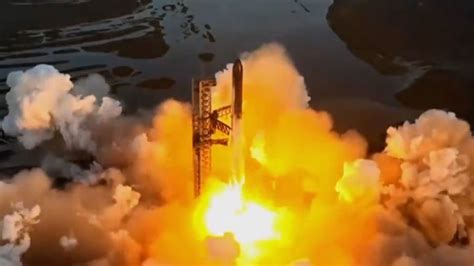
SpaceX’s Starship, during its fourth integrated flight test, experienced a fiery end in the atmosphere, prompting Elon Musk to describe the event with his characteristic brevity as a “rapid unscheduled disassembly.” Despite the dramatic conclusion, the test flight achieved significant milestones, bringing SpaceX closer to its goal of a fully reusable transportation system designed to carry crew and cargo to Earth orbit, the Moon, Mars, and beyond.
The fourth integrated flight test of Starship, launched from Starbase in South Texas, aimed to achieve a controlled reentry of both the Super Heavy booster and the Starship upper stage. While the booster successfully executed a soft splashdown in the Gulf of Mexico, the Starship encountered challenges during its descent, ultimately resulting in its disintegration over the Indian Ocean.
“Despite losing many tiles and a damaged flap, Starship made it all the way to a soft landing in the ocean!” Musk posted on X. “Congrats SpaceX team on an exciting and successful test!”
The flight marked a crucial step forward in the development of Starship, providing valuable data and insights for future iterations. SpaceX engineers are meticulously analyzing the telemetry and recovered debris to identify the root causes of the Starship’s demise and implement corrective actions. The company remains optimistic about the program’s long-term prospects, emphasizing the iterative nature of space exploration and the importance of learning from each flight.
Key Milestones Achieved:
The fourth integrated flight test achieved several critical milestones that significantly advanced the Starship program:
- Successful Booster Splashdown: The Super Heavy booster successfully executed a controlled descent and splashdown in the Gulf of Mexico. This demonstrated the viability of the booster’s return and reuse capabilities, a key element of Starship’s cost-effectiveness.
- Starship Reentry: Starship successfully reentered the Earth’s atmosphere, enduring extreme temperatures and aerodynamic forces. Although the vehicle ultimately broke apart, the reentry provided valuable data on the performance of its heat shield and control systems.
- Hot-Staging Test: The hot-staging separation technique, where the Starship upper stage ignites its engines before separating from the booster, was successfully demonstrated. This maneuver is crucial for maximizing the payload capacity of the Starship system.
- Data Acquisition: The flight generated a wealth of data on all aspects of the Starship system, from engine performance to aerodynamic characteristics to thermal protection. This data is invaluable for refining the design and operation of future Starship vehicles.
- Advancements in Control: Starship demonstrated advanced control capabilities during reentry, maintaining a stable attitude despite significant aerodynamic forces and the loss of multiple heat shield tiles.
Technical Details and Challenges:
The Starship vehicle, composed of the Super Heavy booster and the Starship upper stage, is the largest and most powerful rocket ever built. Its development presents numerous technical challenges, including:
- Heat Shield Performance: The Starship’s heat shield, composed of thousands of individual hexagonal tiles, is designed to protect the vehicle from the extreme temperatures generated during reentry. The loss of multiple tiles during the fourth flight test highlights the need for further refinement of the heat shield design and installation process.
- Engine Reliability: The Raptor engines, which power both the Super Heavy booster and the Starship upper stage, are highly complex and technologically advanced. Ensuring the reliability and performance of these engines is crucial for the success of the Starship program.
- Aerodynamic Control: Maintaining stable aerodynamic control during reentry, when the vehicle is subjected to extreme forces and temperatures, is a significant challenge. The Starship’s control surfaces and reaction control system must be precisely calibrated to ensure stability.
- Manufacturing Scalability: Producing the Starship vehicle at scale requires the development of new and innovative manufacturing techniques. SpaceX is continuously working to improve its manufacturing processes and reduce the cost of building Starships.
- Rapid Reusability: The Starship is designed to be fully reusable, which requires the development of robust and reliable systems for landing and refurbishment. Achieving rapid reusability is essential for making space travel more affordable and accessible.
Historical Context and Future Implications:
The development of Starship represents a major step forward in the history of space exploration. The vehicle’s unprecedented size, power, and reusability have the potential to revolutionize access to space, enabling new missions and capabilities that were previously impossible.
- Lunar Missions: Starship is a critical component of NASA’s Artemis program, which aims to return humans to the Moon by 2025. A modified version of Starship will serve as the Human Landing System, transporting astronauts from lunar orbit to the surface of the Moon and back.
- Mars Colonization: Elon Musk has long envisioned Starship as the key to establishing a permanent human presence on Mars. The vehicle’s large payload capacity and reusability make it well-suited for transporting the vast quantities of supplies and equipment needed to build a self-sustaining Martian colony.
- Space Tourism: Starship has the potential to make space tourism more accessible to a wider range of people. The vehicle’s large cabin could accommodate dozens of passengers, offering them the opportunity to experience the thrill of spaceflight.
- Scientific Research: Starship could be used to deploy large telescopes and other scientific instruments into space, enabling new discoveries about the universe. The vehicle’s large payload capacity would allow for the deployment of more sophisticated and capable instruments than ever before.
- Point-to-Point Travel: In the long term, Starship could be used to transport passengers and cargo between destinations on Earth in a fraction of the time it takes by traditional methods. Suborbital flights could potentially travel from New York to Tokyo in under an hour.
Expert Opinions and Industry Reactions:
The Starship program has generated considerable excitement and debate within the space industry. Experts have praised SpaceX for its ambitious goals and innovative approach, while also cautioning about the significant technical and financial challenges involved.
“SpaceX is pushing the boundaries of what is possible in space exploration,” said Dr. Emily Carter, a professor of aerospace engineering at MIT. “The Starship program has the potential to revolutionize access to space and enable new missions that were previously unimaginable.”
However, some experts have raised concerns about the program’s aggressive schedule and the potential for cost overruns. “Developing a fully reusable space transportation system is an incredibly complex undertaking,” said John Logsdon, a space policy expert at George Washington University. “SpaceX will need to overcome significant technical and financial challenges to achieve its goals.”
Other industry players have reacted with a mix of admiration and caution. Blue Origin, the space company founded by Jeff Bezos, is developing its own heavy-lift rocket, New Glenn, which is intended to compete with Starship. United Launch Alliance (ULA), a joint venture between Boeing and Lockheed Martin, is also developing a new rocket, Vulcan Centaur, which is designed to serve a variety of government and commercial customers.
The Iterative Development Process:
SpaceX’s approach to developing Starship is based on an iterative process of testing and refinement. Each flight test is designed to push the boundaries of the vehicle’s capabilities and identify areas for improvement. The company’s engineers meticulously analyze the data from each flight and implement corrective actions before the next iteration.
This iterative approach has been instrumental in SpaceX’s success in developing other rockets, such as the Falcon 9 and Falcon Heavy. By learning from each flight and continuously improving its designs, SpaceX has been able to achieve remarkable progress in a relatively short period of time.
Environmental Considerations:
The environmental impact of the Starship program is a topic of ongoing debate. The vehicle’s Raptor engines burn methane and liquid oxygen, which produce carbon dioxide and water vapor as exhaust products. The production and transportation of these propellants also have environmental consequences.
SpaceX is committed to minimizing the environmental impact of its operations and is exploring alternative propellants and manufacturing processes. The company is also working to develop sustainable launch sites and reduce the noise pollution associated with rocket launches.
Financial Implications and Investment:
The Starship program represents a significant financial investment for SpaceX. The company has invested billions of dollars in the development of the vehicle and its associated infrastructure. SpaceX is also seeking funding from external sources, including government contracts and private investors.
The success of the Starship program is crucial for SpaceX’s long-term financial viability. The vehicle’s reusability and large payload capacity have the potential to generate significant revenue from a variety of sources, including lunar missions, Mars colonization, space tourism, and scientific research.
Community and Public Perception:
The Starship program has captured the imagination of people around the world. The vehicle’s ambitious goals and futuristic design have inspired a sense of wonder and excitement about the future of space exploration.
SpaceX has cultivated a strong online community of supporters who closely follow the progress of the Starship program. The company regularly shares updates and videos on social media, providing insights into the development process and engaging with its fans.
However, the Starship program has also faced criticism from some quarters. Concerns have been raised about the environmental impact of rocket launches, the potential for accidents, and the ethical implications of space colonization.
Conclusion:
The fourth integrated flight test of Starship, while ending in a fiery “rapid unscheduled disassembly,” represents a significant step forward in the development of a fully reusable space transportation system. The milestones achieved during the flight, including the successful booster splashdown and Starship reentry, provide valuable data and insights for future iterations.
Despite the challenges and uncertainties, the Starship program holds immense potential for revolutionizing access to space and enabling new missions that were previously impossible. As SpaceX continues to refine its designs and improve its operations, the dream of a future where humans can travel to the Moon, Mars, and beyond may become a reality.
The program’s success hinges on overcoming significant technical hurdles, managing costs effectively, and addressing environmental concerns. However, the potential rewards are enormous, promising to transform our understanding of the universe and our place within it. Elon Musk’s vision, coupled with SpaceX’s relentless pursuit of innovation, continues to drive the Starship program forward, even in the face of setbacks. The “rapid unscheduled disassembly” is merely a chapter in the ongoing saga of Starship, a testament to the challenges and triumphs inherent in pushing the boundaries of human exploration.
Frequently Asked Questions (FAQ):
-
What does Elon Musk mean by “rapid unscheduled disassembly”?
- “Rapid unscheduled disassembly” is a tongue-in-cheek term often used in the aerospace industry to describe an explosion or catastrophic failure of a rocket or spacecraft. In this context, it refers to the disintegration of the Starship vehicle during its reentry into Earth’s atmosphere. It’s a humorous way to describe a destructive event, downplaying the seriousness while acknowledging the failure.
-
What were the main goals of Starship’s fourth integrated flight test?
- The primary goals of the fourth integrated flight test were to achieve a controlled reentry of both the Super Heavy booster and the Starship upper stage. Specifically, SpaceX aimed to execute a soft splashdown of the booster in the Gulf of Mexico and guide Starship to a targeted landing point in the Indian Ocean. The test also aimed to gather critical data on the vehicle’s heat shield performance, aerodynamic control, and engine capabilities during reentry. Another key goal was to test the “hot-staging” separation technique.
-
Was the fourth Starship flight test considered a success despite the “rapid unscheduled disassembly”?
- Yes, despite the Starship’s destruction, the flight test was considered a partial success. The Super Heavy booster achieved a soft splashdown, and the Starship completed a significant portion of its reentry, providing valuable data on its performance under extreme conditions. SpaceX emphasized that the flight achieved several key milestones and contributed significantly to the program’s development. Elon Musk himself congratulated the SpaceX team on an “exciting and successful test,” highlighting the data gathered as a victory.
-
What are the next steps for SpaceX after the fourth Starship flight test?
- SpaceX engineers are currently analyzing the telemetry data and recovered debris from the fourth flight test to identify the root causes of the Starship’s disintegration. They will use this information to refine the design of future Starship vehicles, improve the heat shield performance, and enhance the vehicle’s control systems. The company plans to conduct further integrated flight tests in the coming months, incorporating the lessons learned from previous flights. Parallelly, SpaceX will continue to advance the production rate and capabilities at Starbase.
-
How does the Starship program contribute to NASA’s Artemis program and the future of space exploration?
- Starship is a critical component of NASA’s Artemis program, serving as the Human Landing System (HLS) that will transport astronauts from lunar orbit to the surface of the Moon and back. Beyond lunar missions, Starship’s large payload capacity and reusability make it a key enabler for future Mars colonization efforts, space tourism, and scientific research. It aims to reduce the cost of space travel, opening new avenues for exploration and commercial activities in space. Starship’s development signifies a major step toward making space more accessible and facilitating long-duration space missions.









